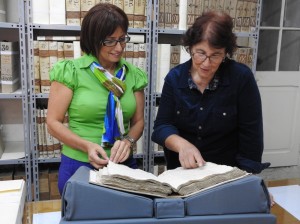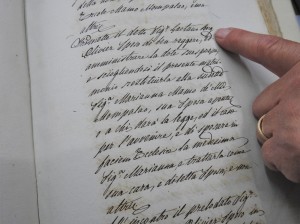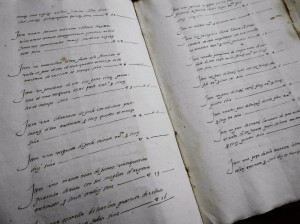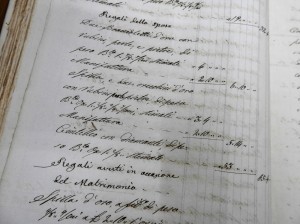Posts Tagged ‘Fra Guglielmo Couppier’
-
IN SICKNESS AND IN WEALTH
Although today, many societies relate marriage to two persons falling in love with each other, in the past, matters were quite different. Some of the local marriages, especially in wealthy families, were pre-arranged at age seven, in order to ensure that the children will marry a partner at par or even one which could enhance their title and possessions.
Parents were expected to provide their daughters with a dowry as a form of marriage payment and at times, as a kind of anticipated inheritance. Generally depending on the couples’ status and on the type of marriage contract which they adopted, this dowry could either serve to assist the newly-wed to establish a new household, or else to act as a mode of protection against the possibility of ill treatment to the bride by her husband and his family, since in the latter cases, the dowry might have to be returned back. A dowry offered also an element of financial security in widowhood, particularly if there were little children in the family.
The Notarial Archives in Valletta possess a treasure trove of stories connected to marriages and dowries of the past. Thick manuscripts with remarkably detailed records of people who lived hundreds of years ago, encapsulate these significant moments in the elegant writing in black ink and brings them back to life, each time someone opens the old pages and reads.
 “One of the earliest contracts of marriages which one can find at these archives is dated to 1467. In it, Zullus Calleja from Naxxar is listing the objects which he is forwarding to the groom as a dowry in name of his daughter Jacoba. The form of this dowry is alla Maltese, and that means that the future husband will only be able to administer these possessions but not to sell them without his wife’s consent. However, once their children are born, this dowry will automatically be divided into three equal parts; one belonging to the husband, the other to the wife, and the rest to the offspring. Nevertheless, the children will not be able to utilize these belongings until they reach age 15,” revealed historian Dr Joan Abela.
“One of the earliest contracts of marriages which one can find at these archives is dated to 1467. In it, Zullus Calleja from Naxxar is listing the objects which he is forwarding to the groom as a dowry in name of his daughter Jacoba. The form of this dowry is alla Maltese, and that means that the future husband will only be able to administer these possessions but not to sell them without his wife’s consent. However, once their children are born, this dowry will automatically be divided into three equal parts; one belonging to the husband, the other to the wife, and the rest to the offspring. Nevertheless, the children will not be able to utilize these belongings until they reach age 15,” revealed historian Dr Joan Abela.Together with Isabelle Camilleri, a diligent worker at the Notarial Archives, Abela prepared a display of manuscripts pertaining to different eras so that I could analyze the interesting data within.
“Whilst I was doing some research about marriage contracts in the old days, I discovered that much of them included also a section marked as dos which related to the dowry being given by the father to the groom. Some of these dowries formed part of the inheritance of the bride and therefore it was declared in the contract that the amount which was being given to her during marriage, would be eventually decreased once she inherits her deceased parents. On the other hand, some contracts stated that this dowry was being donated over and above the future inheritance that the woman will have,” explained Abela.
This study shed light also on different types of dowry contracts which were in existence at the same time during various periods.
 “The most popular ones were the contracts that used the alla Greca or the alla Romana custom, which were practically the same thing. Basically, this type of contract stipulated that all the dowry which was forwarded by the bride’s father to the groom could only be administered by the latter but it could never be alienated without his partner’s approval.”
“The most popular ones were the contracts that used the alla Greca or the alla Romana custom, which were practically the same thing. Basically, this type of contract stipulated that all the dowry which was forwarded by the bride’s father to the groom could only be administered by the latter but it could never be alienated without his partner’s approval.”No matter which style was chosen, all these dowry contracts were quite formal and organized. Experts in each sector of the items being included in the dowry were called upon to evaluate these objects professionally, and their names were included in the contract as a guarantee of genuinity. Ultimately, each of these things were described meticulously in the contract, together with their value at the time.
“Each time that I am working on a new manuscript, I am often delighted at the descriptions that I find. They are so rich in detail that I get the impression of seeing or touching the materials being mentioned, or of smelling the scents and perfumes of the objects in question. I find myself literally in another world as I delve through these pages and read the lists of things that this bride carried with her to her new home,” Camilleri said.
 Dowries of affluent people could be quite impressive. One of these which was in the alla Romana style, had a list of more than 60 objects and was dated to 1557.
Dowries of affluent people could be quite impressive. One of these which was in the alla Romana style, had a list of more than 60 objects and was dated to 1557.“There is so much to ponder in this contract,” remarked Abela. “The one who was making the dowry was the renowned knight Marshall Fra Guglielmo Couppier who took part in the Great Siege of Malta in 1565. Interestingly, Victoria, the bride, had been Couppier’s slave but he had given her freedom. Moreover, in this contract, he was also forwarding a substantial dowry in her name, worth of a highly noble woman, to her future husband Hieronomu Debonè who worked as a bombardier and blacksmith.”
Victoria’s dowry included a 20 year old black male slave and a 59 year old female slave, refined jewelry made of gold, precious stones and pearls, clothes made from the most costly materials such as silk, velvet and wool, and mattresses, pillows, bedsheets and blankets of the finest luxury.
“Another type of dowry contract that was available was known as alla Latina. I didn’t find many of these and I noticed that generally they were used by peasants or families who were not so well-off. In fact, the main aim of such contracts was to help the couple initiate a new life together, since otherwise, this would have been difficult. The agreement in such contracts stated that after a year from their wedding, whatever the couple owned, including the dowry which the bride had brought with her, would belong to both of them. And once children were born, these possessions would be divided into three equal parts between the husband, wife and offsprings.”
Unlike the other types of dowry contracts wherein the husband was bound to return all the dowry objects to his wife’s father, in the same good state, or even better, should their marriage fail for any reason or if the woman died before having any children, the couple which chose the alla Latina contract shared both the good and bad times together.
 Camilleri led me to another manuscript which dated to the 1860 wherein she showed me a long contract that incorporated an inventory of the dowry of a woman who had died and left three small children behind. Her husband was going to get married a second time and so it was required to specify exactly the origin and value of the deceased wife’s possessions.
Camilleri led me to another manuscript which dated to the 1860 wherein she showed me a long contract that incorporated an inventory of the dowry of a woman who had died and left three small children behind. Her husband was going to get married a second time and so it was required to specify exactly the origin and value of the deceased wife’s possessions.“This dowry included also the gifts which she was given during her wedding,” highlighted Camilleri. “Jewelery made the best part of it and it comprised items made of gold, precious stones, pearls and diamonds. Who gives these gifts in weddings nowadays?”
Up to some years ago in Malta, dowries were still handed over to the newly married couple. Most of these couples were provided with practical items which would be useful in their new home, although some admit that they were given so many things that it was hardly possible to use all of them. In fact, a number of them were still lying in cupboards, brand new.
Although one might still encounter a few Maltese couples from the younger generation whose families are adamant to keep this custom alive, the tradition of providing a dowry of goods is certainly dying out. Yet I tend to believe that the dowry itself has not become obsolete but has merely changed form, possibly into money which could be used by the couple to buy a property or to finance their wedding reception.
(This article was published in the Weddings Supplement issued with The Times of Malta of November 4, 2015)
Travelogue
Archives
| M | T | W | T | F | S | S |
|---|---|---|---|---|---|---|
| « Jan | ||||||
| 1 | 2 | 3 | 4 | 5 | 6 | 7 |
| 8 | 9 | 10 | 11 | 12 | 13 | 14 |
| 15 | 16 | 17 | 18 | 19 | 20 | 21 |
| 22 | 23 | 24 | 25 | 26 | 27 | 28 |
| 29 | 30 | |||||
Recent Posts
- A MATTER OF FATE
- MALTA’S PREHISTORIC TREASURES
- THE MAGIC IS IN THE DETAIL
- THE SELLING GAME
- NEVER FORGOTTEN
- Ġrajjiet mhux mitmuma – 35 sena mit-Traġedja tal-Patrol Boat C23
- AN UNEXPECTED VISIT
- THE SISTERS OF THE CRIB
Comments
- Pauline Harkins on Novella – Li kieku stajt!
- admin on IL-KARNIVAL TRAĠIKU TAL-1823
- Albert on IL-KARNIVAL TRAĠIKU TAL-1823
- Martin Ratcliffe on Love in the time of war
- admin on 24 SENA ILU: IT-TRAĠEDJA TAL-PATROL BOAT C23